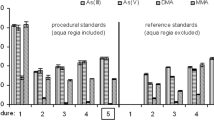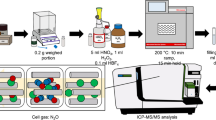Abstract
The weakest step in the analytical procedure for speciation analysis is extraction from a biological material into an aqueous solution which undergoes HPLC separation and then simultaneous online detection by elemental and molecular mass spectrometry (ICP–MS/ES-MS). This paper describes a study to determine the speciation of arsenic and, in particular, the arsenite phytochelatin complexes in the root from an ornamental garden plant Thunbergia alata exposed to 1 mg As L−1 as arsenate. The approach of formic acid extraction followed by HPLC–ES-MS/ICP–MS identified different AsIII–PC complexes in the extract of this plant and made their quantification via sulfur (m/z 32) and arsenic (m/z 75) possible. Although sulfur sensitivity could be significantly increased when xenon was used as collision gas in ICP–qMS, or when HR-ICP–MS was used in medium resolution, the As:S ratio gave misleading results in the identification of AsIII–PC complexes due to the relatively low resolution of the chromatography system in relation to the variety of As–peptides in plants. Hence only the parallel use of ES-MS/ICP–MS was able to prove the occurrence of such arsenite phytochelatin complexes. Between 55 and 64% of the arsenic was bound to the sulfur of peptides mainly as AsIII(PC2)2, AsIII(PC3) and AsIII(PC4). XANES (X-ray absorption near-edge spectroscopy) measurement, using the freshly exposed plant root directly, confirmed that most of the arsenic is trivalent and binds to S of peptides (53% As–S) while 38% occurred as arsenite and only 9% unchanged as arsenate. EXAFS data confirmed that As–S and As–O bonds occur in the plants. This study confirms, for the first time, that As–peptides can be extracted by formic acid and chromatographically separated on a reversed-phase column without significant decomposition or de-novo synthesis during the extraction step.








Similar content being viewed by others
Notes
Here, the term “organo-arsenic species” is not only restricted to compounds with As–C bonds but also to complexes with organic ligands and arsenic as central atom, for example AsIII–PCs.
References
Francesconi KA, Kuehnelt D (2004) Analyst 129:373–395
Hansen HR, Jaspars M, Feldmann J (2004) Analyst 129:1058–1064
Kahn M, Raml R, Schmeisser E, Vallant B, Francesconi KA, Goessler W (2005) Environ Chem 2:171–176
Nischwitz V, Kanaki K, Pergantis SA (2006) J Anal At Spectrom 21:33–40
Hansen HR, Pickford R, Thomas-Oates J, Jaspars M, Feldmann J (2004) Angew Ch Int Ed 43:337–340
Raab A, Schat H, Meharg AA, Feldmann J (2005) New Phytol 168:551–558
Raab A, Meharg AA, Jaspars M, Genney DR, Feldmann J (2004) J Anal At Spectrom 19:183–190
Rauser WE (1995) Plant Physiol 109:1141–1149
Zenk MH (1996) Gene 179:21–30
Cobett SC (2000) Plant Physiol 123:825–832
Meharg AA, Hartley-Whitaker J (2002) New Phytol 154:29–43
Quaghebeur M, Rengel Z (2005) Microchim Acta 151:141–152
Raab A, Ferreira K, Meharg AA, Feldmann J (2007) J Exp Bot 58:1333–1338
Rosenberg E (2003) J Chromatogr A 1000:841–889
Meharg AA, MacNair MR (1992) J Exp Bot 43:519–524
Sheldrick WS, Häusler HJ (1987) Z Anorg Allg Chem 549:177
Schneidersmann C, Hoppe R (1991) Z Anorg Allg Chem 605:67
Trotter J, Zobel T (1995) J Chem Soc 4466
Peters K, Peters EM, von Schnering HG, Wojnowski W, Tamulewicz S, Adacki KR (1997) Z Kristallogr New Cryst Struct 212:343
Bandura DR, Baranov VI, Tanner SD (2001) Fresenius J Anal Chem 370:454–470
Tanner SD, Baranov VI, Bandura DR (2002) Spectrochim Acta B 57:1361–1452
Douglas DJ (1997) J Am Soc Mass Spectrom 9:101–113
Marcus RK (2004) J Anal At Spectrom 19:591–599
Rowan JT, Houk RS (1989) Appl Spectrosc 43:976–980
Wallschläger D, Stadey CJ (2007) Anal Chem 79:3873–3880
Raab A, Feldmann J, Meharg AA (2004) Plant Physiol 134:1113–1122
Raab A, Wright S, Jaspars M, Meharg AA, Feldmann J (2007) Angew Ch Int Ed 46:2594–2597
Hu Z, Hu S, Gao S, Liu Y, Lin S (2004) Spectrochim Acta B 59:1463–1470
Larsen EH, Stürup S (1994) J Anal At Spectrom 9:1099–1105
Bluemlein K, Raab A, Feldmann J (2008) in preparation
Mukhopadhyay R, Rosen BP, Silver S (2002) FEMS Microbiol Rev 26:311–325
Acknowledgements
This work has been supported by NERC (NE/B505789/1). Many thanks to F. Bahrami (STFC Daresbury Laboratory, UK) and Julian Wills (ThermoFisher, Bremen, Germany) for their assistance in using their instrumentation. KB thanks the College of Physical Sciences for her scholarship.
Author information
Authors and Affiliations
Corresponding author
Rights and permissions
About this article
Cite this article
Bluemlein, K., Raab, A., Meharg, A.A. et al. Can we trust mass spectrometry for determination of arsenic peptides in plants: comparison of LC–ICP–MS and LC–ES-MS/ICP–MS with XANES/EXAFS in analysis of Thunbergia alata . Anal Bioanal Chem 390, 1739–1751 (2008). https://doi.org/10.1007/s00216-007-1724-y
Received:
Revised:
Accepted:
Published:
Issue Date:
DOI: https://doi.org/10.1007/s00216-007-1724-y




